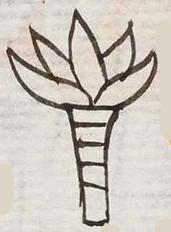izhuatl (Mdz13v)
This element for leaves (izhuatl) has been carved from the compound sign for the place name, Izhuatlan. The glyph consists of a black-line drawing (with no colorants) of a tree or plant matter standing upright/vertical. A number of leaves appear to be bound together at the stems, but this could also be a palm tree, with the horizontal lines being rings on the trunk.
Stephanie Wood
A number of words in Nahuatl refer to leaves of various kinds. Each term might have variations, as well. For instance, izhuatl can refer to palm fronds and the green leaves of the corn/maize plant. The izhuatl leaves from the palm were dried and used for weaving together into a course cloth. [See: The Works of Hubert Howe Bancroft, v. 2, p. 296, regarding the palm leaves and, regarding maize leaves, Anales de Antropología, v. 39 (2005), p. 119.] A native Nahuatl speaker (colleague of Dra. Lidia Gómez García, in the state of Puebla) says that izhuatl refers to leaves that wrap tamales. Izhuatl leaves and perhaps izhuatl firewood both seem to appear in codices from Huexotzinco, such as the one from San Salvador that came to the Library of Congress in 2022.
Stephanie Wood
Stephanie Wood
c. 1541, but by 1553 at the latest
Stephanie Wood
leaves, leaf, hojas, yzvatl, yzuatl

izhua(tl), leaves for wrapping tamales, https://nahuatl.wired-humanities.org/content/izhuatl
leaf
las hojas
Stephanie Wood
Codex Mendoza, folio 13 verso, https://digital.bodleian.ox.ac.uk/objects/2fea788e-2aa2-4f08-b6d9-648c00..., image 37 of 188.
The Bodleian Libraries, University of Oxford, hold the original manuscript, the MS. Arch. Selden. A. 1. This image is published here under the UK Creative Commons, “Attribution-NonCommercial-ShareAlike 3.0 License” (CC-BY-NC-SA 3.0).
